

Dyspraxia, Information, Dyspraxia Symptoms. Dyspraxia is the medical term used when someone finds it difficult to carry out and co-ordinate skilled, purposeful movements and gestures with normal accuracy.

There may be problems with: Gross motor skills - this means problems with the ability to carry out movements that involve the large muscles of the body or groups of muscles. Examples of gross motor skills are walking, jumping, running, hopping on one leg and throwing an object.Fine motor skills - this means problems with performing tasks that are carried out by the smaller muscles of the body, including the muscles of the hands, feet and head or face (including the tongue and the lips). They are more difficult and delicate movements. Examples include writing, drawing, painting, doing a jigsaw puzzle, pronouncing words and whistling. What is Developmental Apraxia of Speech. This excellent article by Ann S.
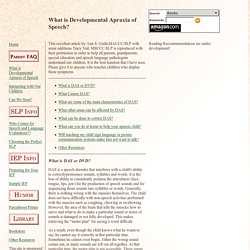
Guild,MACCC/SLP with some additions Tracy Vail, MSCCC/SLP is reproduced with their permission in order to help all parents, grandparents, special educators and speech language pathologists understand our children. It is the best handout that I have seen. Please give it to anyone who touches children who display these symptoms. DAS is a speech disorder that interferes with a child's ability to correctlypronounce sounds, syllables and words.
It is the loss of ability to consistently position the articulators (face, tongue, lips, jaw) for the production of speech sounds and for sequencing those sounds into syllables or words. As a result, even though the child knows what he wants to say, he cannot say it correctly at that particular time. DAS is a neurologically based speech disorder. Dyspraxia Foundation. The Challenging Behaviour Foundation. Early Symptoms of Dyspraxia. The information below is taken from A Practical Manual for Parents and Professionals by Madeleine Portwood and the Developmental Dyspraxia Foundation UK with their kind permission.
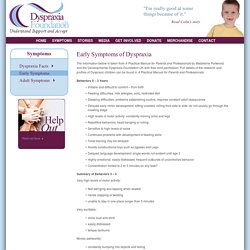
Full details of the research and profiles of Dyspraxic children can be found in A Practical Manual for Parents and Professionals. Behaviors 0 – 3 Years Summary of Behaviors 3 – 5 Very high levels of motor activity: feet swinging and tapping when seatedhands clapping or twistingunable to stay in one place longer than 5 minutes Very excitable: voice loud and shrilleasily distressedtemper tantrums Moves awkwardly: constantly bumping into objects and fallingassociated mirror movements, hands flap when running or jumpingdifficulty pedaling tricycle or similar toyPoor ground awarenessno sense of danger, jump from inappropriate heights Continue to be messy eaters: often spill liquid from drinking cupsprefer to use fingers to feed Avoids constructional toys: jigsawsbuilding blocks (Lego)
Dyspraxia (Children) - Causes - NHS Choices. Little is known about the cause of developmental co-ordination disorder (DCD), although it is thought to be caused by a problem in the development of the brain.
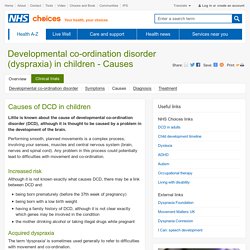
Performing smooth, planned movements is a complex process, involving your senses, muscles and central nervous system (brain, nerves and spinal cord). Any problem in this process could potentially lead to difficulties with movement and co-ordination. Increased risk Although it is not known exactly what causes DCD, there may be a link between DCD and: being born prematurely (before the 37th week of pregnancy) being born with a low birth weight having a family history of DCD, although it is not clear exactly which genes may be involved in the condition the mother drinking alcohol or taking illegal drugs while pregnant. Childhood Verbal Dyspraxia - ENT Wellbeing Sydney. Assessing the impact of FOXP1 mutations on developmental verbal dyspraxia.
Why Bother About Clumsiness? The Implications of Having Developmental Coordination Disorder (DCD) Always the guiding hand': parents' accounts of the long-term implications of developmental co-ordination disorder for their children and families. Developmental Coordination Disorder. Motor coordination is the product of a complex set of cognitive and physical processes that are often taken for granted in children who are developing normally.
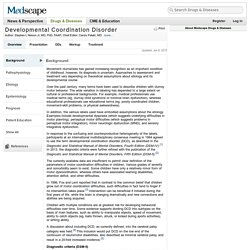
Smooth, targeted, and accurate movements, both gross and fine, require the harmonious functioning of sensory input, central processing of this information in the brain, and coordination with the high executive cerebral functions (eg, volition, motivation, and motor planning of an activity). Also required is the performance of a certain motor pattern. All of these elements must work in a coordinated and rapid way to enable complex movements involving different parts of the body.
At present, our understanding of motor development in humans and the pathophysiology of motor clumsiness is still in its infancy. Because of the heterogeneity in the presentation and definition of DCD, finding its cause has been difficult. The neuronal group–selection model combines aspects of the 2 aforementioned models. Muscular tone. Developmental Disorder Coordination Questionnaire. Toward An Understanding of Developmental Coordination Disorder: Terminological and Diagnostic Issues. Toward An Understanding of Developmental Coordination Disorder: Terminological and Diagnostic Issues. Terminology used in research reports of developmental coordination disorder. Neuro-motor-immaturity-northuberland-and-berkshire-paper-Report-By-SGB. Developmental coordination disorder: MedlinePlus Medical Encyclopedia. Dyspraxia in adults - NHS Choices. Dyspraxia is a common disorder that affects movement and co-ordination.
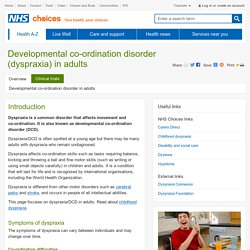
It is also known as developmental co-ordination disorder (DCD). Dyspraxia/DCD is often spotted at a young age but there may be many adults with dyspraxia who remain undiagnosed. Dyspraxia affects co-ordination skills such as tasks requiring balance, kicking and throwing a ball and fine motor skills (such as writing or using small objects carefully) in children and adults. It is a condition that will last for life and is recognised by international organisations, including the World Health Organization.